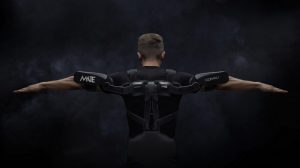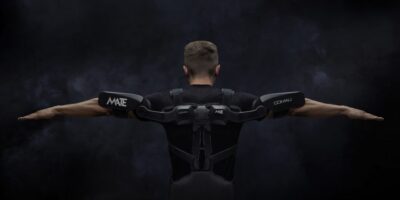Fleshing out the skeleton of robotics
Wearable robotic exoskeletons are not a new concept. They were first envisaged in 1890, to help support the wearer with walking, running and jumping. As materials and communication technology improves, the market is experiencing a boom in industrial, healthcare, defence and consumer applications, writes Caroline Hayes.
Part of the increase in the wearable robotic exoskeleton market is due to the introduction and ready availability of soft actuators, 3D printed exoskeleton structure, and efficient, long-lasting Li-Ion batteries. Initially, the healthcare market saw high growth rates as the exoskeleton is used for therapy to treat patients suffering from neurological and musculoskeletal disorders. Research company, BIS Research has identified that healthcare is the dominant market for wearable robotic exoskeletons, where they are used for rehabilitation, assistance and body part support. They are also used for sports to train and help athletes as well as in defence where they can support military personel. In a report on the global wearable robotic exoskeleton market, it identifies the robotics industry as a significant area of focus. As with healthcare and rehabilitation, it is used for repeatable movements, to improve levels of endurance and safety in industrial environments. The research finds that the total wearable robotic exoskeleton market generated $96.0 million in 2016 and, although set to grow, it is expected to be “several years to reach its full market potential and commercialization”. Part of the delay in adoption is the weight of motors used and the slow movements and limited duration periods.
Figure 1: Global wearable robotic exoskeleton market analysis by industry, 2016-2026 (Source: BIS Research)

Healthcare leads in market growth, largely due to the considerable spend on healthcare in North America, Europe and Asia, for rehabilitation and to meet the needs of each region’s ageing populations.
In 2016, notes the report, exoskeletons for the defence sector were limited to test trials and R&D, while sales in the commercial market, to improve golf swing for example, are described as “not noticeable”.
Europe, something of a hotbed for passive exoskeleton start-ups, is expected to have the highest market share, during 2016 to 2026, followed by Asia Pacific, North America and the rest of the world.
This month, the Italian industrial automation company, Comau, launched an industrial wearable exoskeleton at Automatica in Munich (19 to 22 June).
The MATE Fit for Workers exoskeleton is designed to improve work quality by providing consistent and advanced movement assistance during repetitive, for ergonomic, reliable and safe operation.
Figure 2: The MATE Fit for Workers exoskeleton was launched at Automatica, Munich

It uses a spring-based passive structure for what the company describes as lightweight and breathable postural support without the need for batteries, motors or other devices that may be failure-prone, adds Comau. The company consulted with factory workers who conduct manual activities in their daily work to create an exoskeleton that creates a naturally comfortable, breathable postural structure. The exoskeleton’s compact structure is designed to follow the movements of upper limbs without resistance or misalignment to support the wearer’s natural movements.
In trials, researchers recorded a reduction of shoulder muscle activity for some muscles of up to 50 percent, enabling the wearer to perform the same task repetitively with less fatigue than without it. It was also found that the consistent, ergonomically-assisted movement support increases the quality and precision of repetitive tasks.
The company partnered with ÖSSUR, a non-invasive orthopedics company and IUVO, a spin-off of The BioRobotics Institute (Scuola Superiore Sant’Anna) specialising in wearable technologies devices to develop the compact and ergonomically designed exoskeleton. The resulting exoskeleton is able to replicate any movement of the shoulder while adhering to the body like a “second skin”, responding directly to the wearer’s needs. Tobias Daniel, vice president, robotics and automation products global sales and marketing, Comau, commented: “With our exoskeleton, [wearers] will be able to do the same tasks but with less fatigue. For Comau, this is also an extraordinary opportunity to reach a global market that, according to the IFR, grew more than 60 per cent from 2015 to 2017 and is estimated to continue growing at a rate of 25% each year until 2020. We believe that the industrial sector will represent about one third of the exoskeleton’s applications.”
MATE is part in the company’s HUMANufacturing Technology strategy, which focuses on improving the role of humans in the much-vaunted smart factory, together with digital tools, for industrial robotics within a networked production system. The exoskeleton is the first of a series of wearable robotics that Comau is developing and commercialising in partnership with IUVO and Össur.
About Comau
Comau, a member of the FCA Group, is a worldwide leader in delivering advanced industrial automation products and systems. Combining innovative engineering solutions with enabling technologies, Comau helps companies leverage the full potential of digital manufacturing.
In addition to a vast range of modular, flexible and highly-configurable products, Comau offers interconnected digital service solutions able to transmit, elaborate and analyze important machine and process data, thereby increasing efficiency for smart manufacturing. The full portfolio includes: joining, assembly and machining solutions for traditional and electric vehicles, robotized manufacturing systems, a complete family of robots with extensive range and payload configurations, autonomous logistics, and asset optimization services with real-time monitoring and control capabilities. The offering also extends to project management and consultancy, IoT services, and maintenance and training for a wide range of industrial segments.
Headquartered in Turin, Italy, Comau has over 45 years of factory-proven experience and an international network of 32 locations, 14 manufacturing plants and 5 innovation centers that span 14 countries and employ more than 9,000 people. A global network of distributors and partners allows the company to respond quickly to the needs of customers of all sizes, no matter where they are located throughout the world. Comau is also committed to improving human – machine collaboration by developing competencies through the formation of individuals and groups as part of its open automation approach. This includes hands-on training programs by Comau Academy that develop the technical and managerial competencies necessary to face the challenges and opportunities of Industry 4.0.




